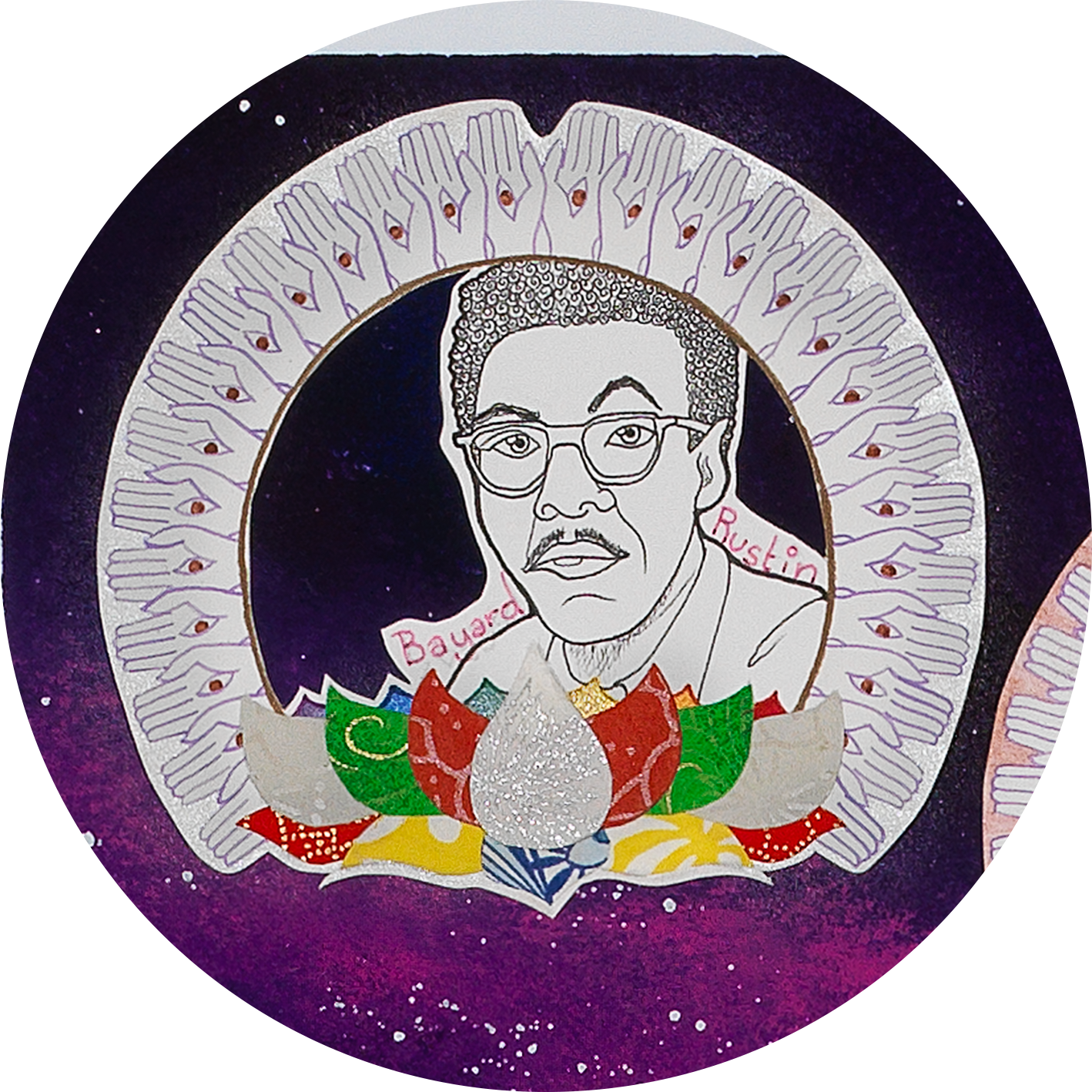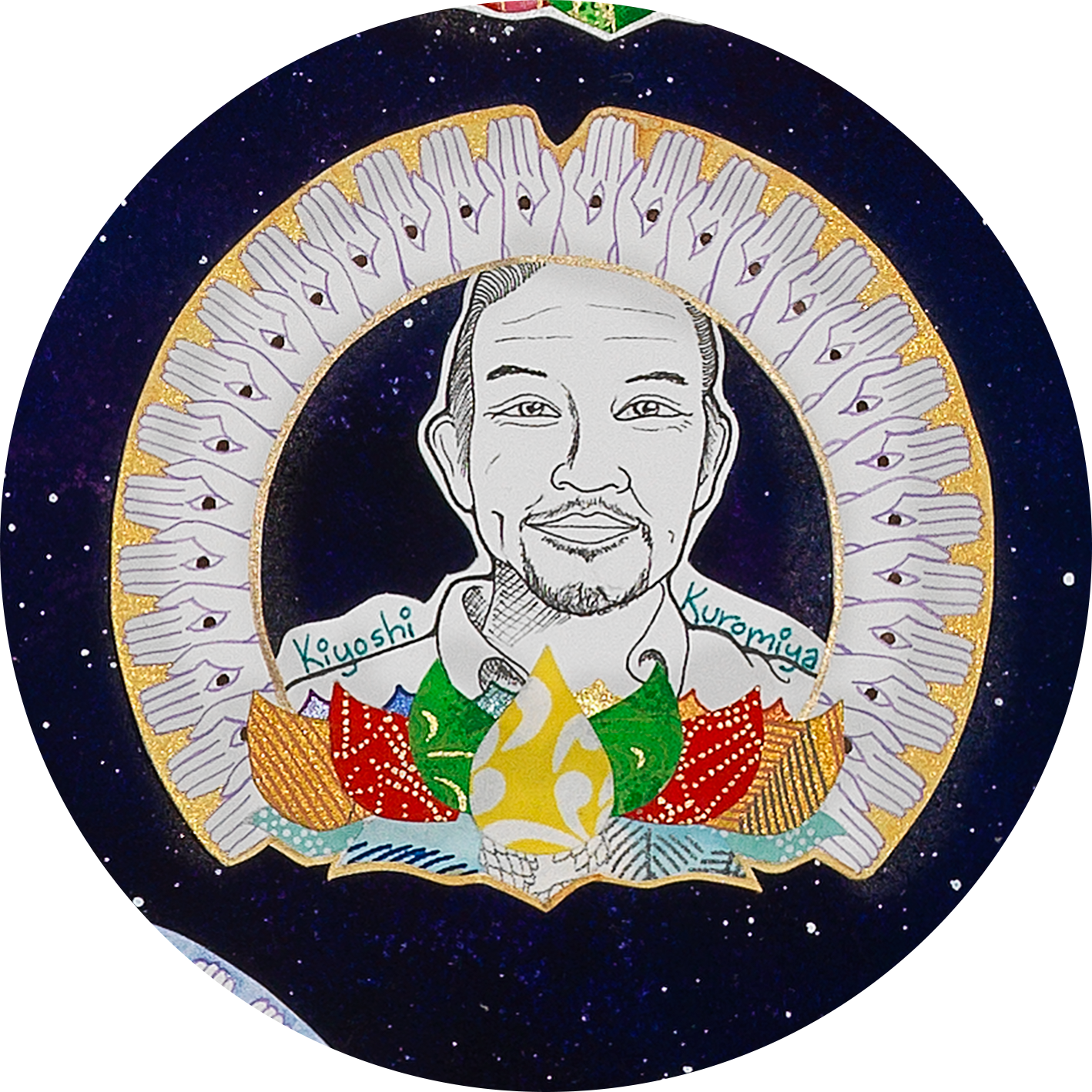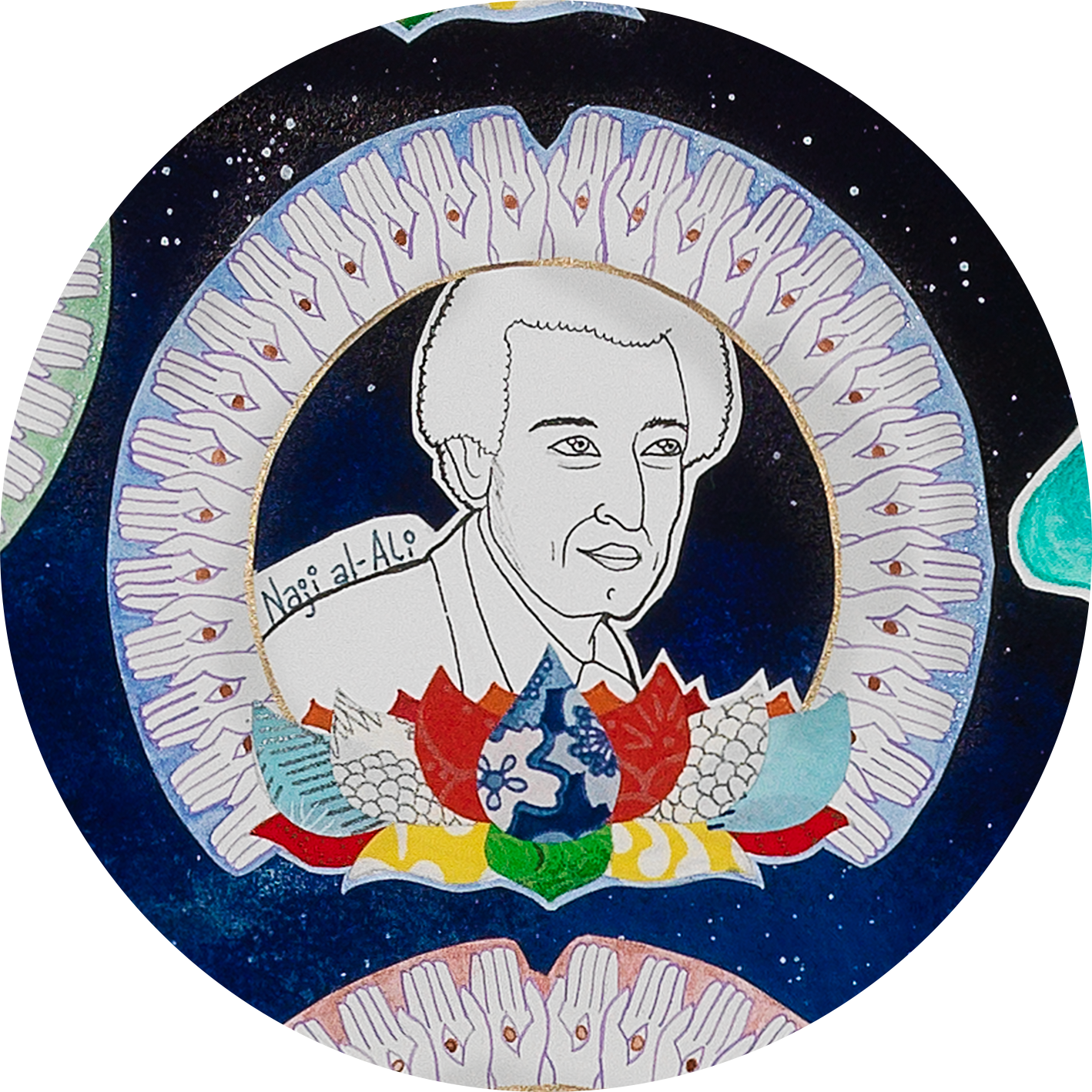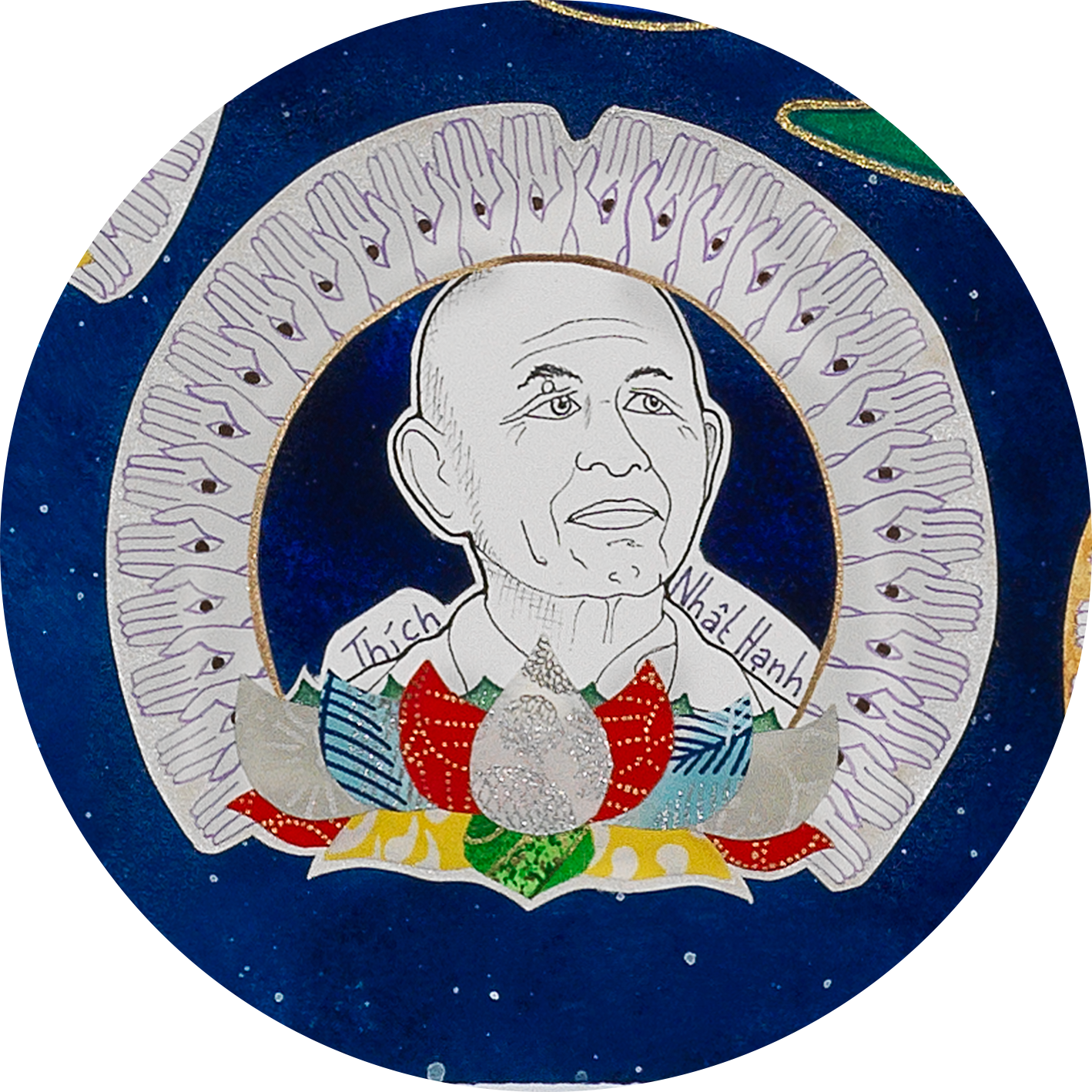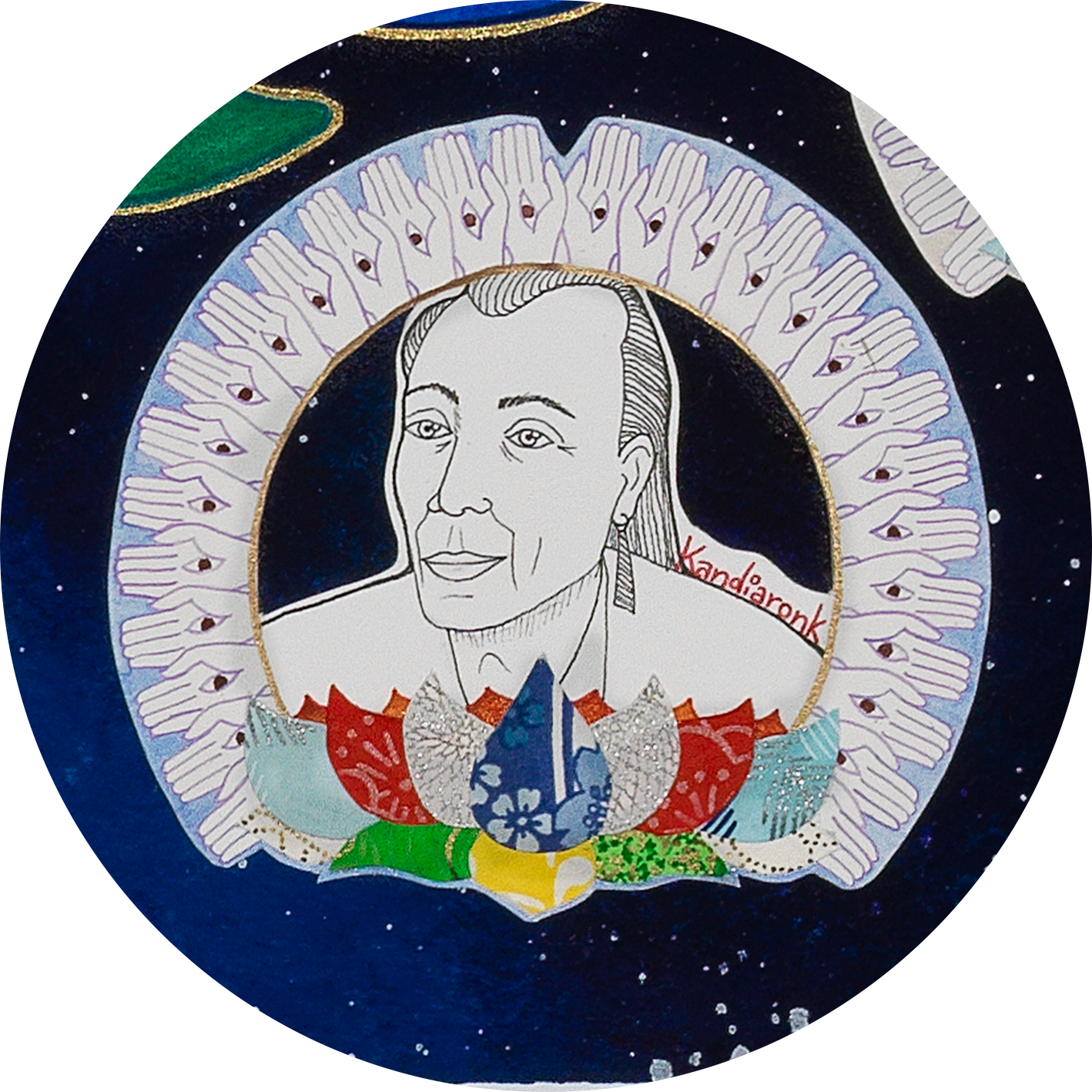
Meet the Ancestors
As a practice…
We invite you to write letters to any or all of the ancestors as a way to connect deeper to the lineage of liberation and the people whom have passed on the work of bending history towards justice and liberation for all.
Contemplate that you may be living the wildest dreams of some of these ancestors—your life and liberation is something they imagined and is only possible because of that imagining.
Consider what it means to move into a lineage of liberation alongside these ancestors.
To aid in these practicies, each ancestor has at least one resource linked so you can get to know them better.
Marsha P. Johnson
Though it’s widely disputed, Marsha P. Johnson is often credited as the person who started the Stonewall Uprising in 1969 by “throwing the first brick.” While we can never know for sure how it started, we do know Marsha was there and continued to show up for trans and gay liberation until her death. Johnson, alongside her friend Sylvia Rivera, founded S.T.A.R., the Street Transvestite Action Revolutionaries.
To learn more about Johnson’s life and activism, the artist recommends the documentary The Death & Life of Marsha P. Johnson, as well as the book Marsha: The joy and defiance of Marsha P. Johnson by Tourmaline. You can also support living artist Micah Bazant* by purchasing a print of the portrait they made of Marsha P. Johnson.
“Darling, I want my gay rights now!”
* “No pride for some of us without liberation for all of us” is text Bazant put on several portraits they made of trans women. This is now commonly misattributed as a quote by Johnson herself.
Sylvia Rivera
Like her friend, Marsha P. Johnson, Sylvia Rivera fought for trans and gay liberation and was a co-founder of S.T.A.R., the Street Transvestite Action Revolutionaries. Rivera also called for class solidarity and was unflinching in calling out cisgender and white gays and lesbians for the ways they often neglect and leave behind BIPoC and trans community members.
To learn more about Rivera’s life and activism, the artist recommends the documentary The Death & Life of Marsha P. Johnson, which largely featured Rivera in the aftermath of Johnson’s murder. You can also watch footage of Rivera at a World Pride event, calling for class solidarity with imprisoned trans folks.
“I believe in us getting our rights, or else I would not be out there fighting for our rights.”
Stacey Park Milbern
The artist is close friends with many folks who were in community with Stacey Park Milbern. Her work in the world helped to grow the Disability Justice movement significantly as she fought for the bodily autonomy and sacredness of all lives. She was also committed to class solidarity, recognising the ways ableism and classism intersect to keep disabled people impoverished.
Alice Wong, of the Disability Visibility website, wrote a powerful memorial for Park Milbern. Park Milbern wrote a piece about crip ancestorship for Disability Visibility. She also has a feature page at Google Arts & Culture.
“It is such a painful experience to be left behind or disregarded. I have experienced feeling neglected by systems and society, and I don’t want that to continue. If I can use my skills developing care networks to keep someone a little more safe, it was all worth it.”
Louis Riel
The artist is a descendant of Louis Riel’s family and the Red River Métis, a culturally specific group of mixed Indigenous and coloniser peoples who resisted the tyranny of the British Government. Riel, along with many others in his community, advocated for the rights of the Métis people to protect their way of life and retain control over their land. Riel is credited with leading two resistances against the British Government as Canada was forming as a country and being imposed on the people already living there.
The Manitoba Métis Federation continues to fight for sovereignty and to protect and pass along Métis culture. The artist recommends the graphic novels A Girl Called Echo, by katherena vermette and Louis Riel by Chester Brown. You can also learn more about Riel through the Canadian Encyclopedia.
“Deeds are not accomplished in a few days, or in a few hours. A century is only a spoke in the wheel of everlasting time.”
Bayard Rustin
One of the key organizers of the March on Washington, Bayard Rustin was a long time activist in the Civil Rights movement in the United States. A close personal friend of Martin Luther King Jr., Rustin used his organizational skills and connections to build a strong community of resistance fighters. He was also a gay man, which is only a more recently talked about aspect of his identity, despite how much it informed his activism.
The National Museum of African-American History & Culture has a feature page about Rustin. The artist also recommends the film Rustin, which was produced by Netflix.
“If we want to do away with the injustice to gays it will not be done because we get rid of the injustice to gays. It will be done because we are forwarding the effort for the elimination of injustice to all. And we will win the rights for gays, or blacks, or Hispanics, or women within the context of whether we are fighting for all.”
Mary Oliver
It is hard to not be familiar with the works of Mary Oliver, a prolific poet whose writing has touched thousands. The artist included Oliver as an ancestor for how much her poems uplift the importance of having a relationship to the Earth, and seeing ourselves as part of it. Oliver was also an out lesbian in the world from a very early age, and so offered representation when the artist was first finding language for xyr own sexuality.
Oliver was an incredibly private person, and so it was a gift when she opted to be interviewed for On Being. This is well worth the listen, along with finding any of Oliver’s poetry and spending time with it.
“Whoever you are, no matter how lonely, / the world offers itself to your imagination, / calls to you like the wild geese, harsh and exciting — / over and over announcing your place / in the family of things.”
Lou Sullivan
Lou Sullivan was one of the essential forces in developing a system of healthcare for transmasculine folks in the United States. The artist learned about him during an interview with a friend, who shared Sullivan’s diaries and work as an inspiration to them.
You can read his collected journals in the book We Both Laughed in Pleasure. You can also learn more about him through the website created for the project of turning his journals into a book.
“How strange it seems that education, in practice, so often means suppression: that instead of leading the mind outward to the light of day it crowds things in upon it that darken and weary it.”
Lucy Hicks-Anderson
While there is no record of Lucy Hicks-Anderson being an activist, per se, the artist included her as one of the earliest examples of a trans person resisting being misgendered, and how very possible it is for parents and doctors to simply respect a child’s autonomy. Hicks-Anderson’s mother took her to a doctor at a very early age because her child so insisted she was a girl. The doctor said her mother should simply raise her as a girl, and so she did. She lived her entire life in the gender she knew herself to be, despite arrest and being charged with fraud for marrying a man.
There are unfortunately very few records of Hicks-Anderson, but you can learn more of what we do know from her place in the Legacy Project of Chicago. You can also support fellow queer artist Michelle Rosenthal by purchasing a print of her portrait of Hicks-Anderson.
“I defy any doctor in the world to prove that I am not a woman. I have lived, dressed, acted just what I am, a woman.”
Judy Heumann
Dubbed the mother of the Disability Rights movement, Judy Heumann was an activist and community organizer. Despite this title, Heumann was incredibly humble in her life, and always gave credit to others for every win she was involved in for the rights and liberation of Disabled folks.
Heumann is also featured in Crip Camp, alongside Brad Lomax. Her memoir, Being Heumann, is on of the artist’s favourite memoirs. You can learn about her incredible legacy on her official website.
“Change never happens at the pace we think it should. It happens over years of people joining together, strategizing, sharing, and pulling all the levers they possibly can. Gradually, excruciatingly slowly, things start to happen, and then suddenly, seemingly out of the blue, something will tip”
Brad Lomax
Brad Lomax was a member of the Black Panther party and key participant in the 504 sit-in of the Disability Rights movement, from which the Disability Justice movement emerged. Lomax’s involvement with the Panthers was essential to the success of the 504 sit-in, as he called in his brothers to provide support to the protestors when the government was actively trying to starve them out and preventing necessary medication from getting into the building.
There is very little on the record about Lomax’s life, but we are fortunate to have a few stories—you can see Lomax in the documentary Crip Camp, and the story of his essential role in getting the Panthers to support the sit-in is included in Judy Heumann’s incredible memoir. The Centre for Learner Equity also has a feature page about Lomax.
“By far the most critical gift given us by our allies was the Black Panthers’ comittment to feed each protester in the building one hot meal every day…The Panthers’ representative explained that the decision of Panthers Brad Lomax and Chuck Jaskon to participate in the sit-in necessitates a Panther response....if Lomax and Jaskon thought we were worth their dedication, then the Panthers would support all of us”
Pauli Murray
The artist first learned about Pauli Murray in conversation with a friend who considers Murray to be an ancestor and model for how to live well. Murray was a true polymath: A scholar, activist, poet, priest and lawyer. They lived a life committed to human rights and liberation across race, gender, sexuality and class.
You can learn more about Murray through the Pauli Murray Center website, and by reading the book Pauli Murray’s Revolutionary Life by Simki Kuznik.
“When my brothers try to draw a circle to exclude me, I shall draw a larger circle to include them. Where they speak out for the privileges of a puny group, I shall shout for the rights of all mankind.”
Larry Kramer
One of the co-founders of ACT UP, Larry Kramer became known for his unrelenting drive to push the United States Food & Drug Administration to fund research for AIDS treatments. Kramer had a reputation of being unapologetic and brutally honest about what the United States government’s neglect was doing to AIDS patients. Kramer was also a playwrite and an author.
The artist highly recommends the documentary about Kramer’s life, Larry Kramer in Love and Anger. You can also read about his life on the Biography website.
“Activism is very sustaining. But I don’t view myself as a political person. I’m just someone who desperately wants to stay alive.”
bell hooks
The life and legacy of bell hooks has touched so many people, including almost every person the artist has been in community with. hooks’ work focused most strongly on love and the power love has to transform our hearts and minds and help us in the work of dismantling systemic oppression.
A prolific author, the artist recommends looking into any of hooks’ writing simply by choosing the book title that most speaks to you. hooks has been a guest on many podcasts and given many interviews, so search for her work and engage with it in whatever way fits best for you. You can also read about her life and legacy on the National Museum of African-American History & Culture website.
“Dominator culture has tried to keep us all afraid, to make us choose safety instead of risk, sameness instead of diversity. Moving through that fear, finding out what connects us, reveling in our differences; this is the process that brings us closer, that gives us a world of shared values, of meaningful community.”
Gloria Anzaldúa
A feminist philosophy, Gloria Anzaldúa’s work examined what we would now call “intersectionality”, years before the term was coined by Kimberlé Crenshaw. Anzaldúa was committed to queer liberation, class solidarity, anti-racism and gender equity. Alongside her academic work, she was also a poet and an artist who used her creative practice to relate to the periods of depression she experienced in her life.
You can learn more about Anzaldúa’s entire body of work through her official website.
“What am I? A third world lesbian feminist with Marxist and mystic leanings. They would chop me up into little fragments and tag each piece with a label. You say my name is ambivalence? Think of me as Shiva, a many-armed and many legged body with one foot on brown soil, one on white, one in straight society, one in the gay world, the man’s world, the women’s, one limb in the literary world, another in the working class, the socialist, and the occult world. A sort of spider woman hanging by one thin strand of web. Who, me, confused? Ambivalent? Not so. Only your labels split me.”
Grace Lee Boggs
A direct mentor to many of the artist’s friends, Grace Lee Boggs was an incredible community organizer. Committed to dismantling white supremacy, Boggs knew that radical social change begins with the relationships closest to you. She modeled the importance of local community building and strength.
We are so blessed to have many writings and recordings by and about Grace Lee Boggs. We invite you to begin with this conversation on On Being. You can learn more about Boggs’ life and work, and the work of her husband, James, through the Boggs Foundation website.
“Real poverty is the belief that the purpose of life is acquiring wealth and owning things. Real wealth is not the possession of property but the recognition that our deepest need, as human beings, is to keep developing our natural and acquired powers to relate to other human beings.”
Kiyoshi Kuromiya
Prior to starting on this thangka, the artist had never heard of Kiyoshi Kuromiya, despite his incredibly rich activist life. Kuromiya was a co-founder of the Gay Liberation Front, personal assistant to Dr. Martin Luther King Jr., a delegate at the Black Panther Convention, a member of ACT UP Philadelphia, and founder of the Critical Path Project.
The artist offers the deepest gratitude to the folks at the Legacy Project Chicago for making a record of Kuromiya’s life and legacy.
“Art is not just a mirror of society, it is a catalyst for social change and a visionary force for a better world.”
Audre Lorde
Committed to queer and Black liberation, Audre Lorde is probably one of the most well known and prolific feminists of the 20th century. Her work has influenced great living activists, like adrienne maree brown and Alexis Pauline Gumbs, and she is an icon in the Disability Justice movement, Black Lives Matter, and the fight for queer and trans liberation. Her work continues to be relevant on many levels, from critiques of white feminism to understanding the need for universal, guaranteed healthcare.
If you’ve not read anything by Audre Lorde, the artist highly recommends her two memoirs: Zami: A new spelling of my name, and The Cancer Journals. You can also learn more about her life and legacy through the Audre Lorde Project website, and by reading Alexis Pauline Gumbs’ book Survival is a Promise.
“I cannot afford the luxury of fighting one form of oppression only. I cannot afford to believe that freedom from intolerance is the right of only one particular group.”
Anne Braden
During an anti-racism workshop specifically for white women, the facilitator introduced the artist to Anne Braden. Braden and her husband were committed to dismantling white supremacy in a very real way, understanding that to be anti-racist is to expect retaliation from those who uphold systemic racism. Braden’s work and life is an example of understanding that none of us are free until all of us are free.
The documentary, Anne Braden: Southern Patriot, is a wonderful way to start learning more about this incredible person. You can also learn more about her through the Americans Who Tell the Truth portrait project by Robert Shetterley.
“As long as people of color can be written off as expendable, and therefore acceptable victims of the most extreme inequities, none of the basic injustices of our society will be addressed; they will only get worse.”
James Baldwin
A person of great whit and insightful commentary, James Baldwin was a prolific writer and great thinker. His work continues to impact people today, as his insights and reflections on the United States experiment remain relevant. He was a strong advocate for racial liberation and anti-racism, but also spoke of queer liberation and joy and love.
The artist highly recommends all of Baldwin’s writing. You can find his books through your local library, and read his collected essays at Archive.org. Baldwin’s work is the inspiration for the Baldwin Institute, an organization committed to carrying on his legacy through literature and the arts.
“Not everything that is faced can be changed. But nothing can be changed without being faced.”
Leslie Feinberg
Stone Butch Blues is considered one of the most influential queer books of at least two generations. Feinberg’s prose captured a particular time in human history when we didn’t yet have the language to describe trans experiences, including non-binary and agender experience. For many trans folks, Feinberg’s writing was the first time they saw themselves reflected in a piece of media in a way that wasn’t hateful and bigoted. Zie was a committed anti-racist who fought for class solidarity throughout hir life.
Feinberg’s legacy lives on in her written work, which you can find at your local library, both Stone Butch Blues and Drag King Dreams. You can learn more about zir activism and commitment to radical social change through hir website.
“My right to be me is tied with a thousand threads to your right to be you.”
Naji al-Ali
During the research period when the artist was looking into symbols to place in each of Avalokiteshvara’s prominent hands, they learned about Naji al-Ali’s work. A cartoonist, al-Ali created Handala, the figure of a scruffy looking child with hands clasped behind his back, which has come to represent the decolonial movement for a free Palestine. Al-Ali said the face of the child would be revealed only when the Palestinian people regained their sovereignty. Handala is a wonderful example of art as an act of resistance.
There is unfortunately very little record of al-Aji’s life, which was cut short by a gunman in 1987. Middle East Eye does have a piece about his work and the influence and impact of Handala for the Palestinian people.
“The road to Palestine is not far or near, it is the distance of the revolution”
Shatzi Weisberger
The artist learned of Shatzi Weisberger thanks to social media posts of her holding signs with sassy slogans at protests against police brutality and the bombing of Palestine. Dubbed ‘The People’s Bubbie’, Weisberger was an outspoken anti-zionist, anti-racist, and proud lesbian. In her 92 years of life she was a nurse, an advocate for AIDS patients, and a participant in the Civil Rights movement, Black Lives Matter, and the movement for a free Palestine.
Jewish Currents published an interview with Weisberger just before her 90th birthday. There is a lovely obituary for her by Out Front Magazine.
“My advice to all you dears in tough times: Celebrate your wins. Celebrate them together, in the streets. It will grow you and your collective power.”
Manuel Terán/Tortuguita
An eco-anarchist and committed direct action activist, Tortuguita left a legacy of love and community care in the Stop Cop City movement in Atlanta. They are remembered by those who knew them as a warm-hearted, kind, and generous person who expressed empathy at the deepest level.
It is the artist’s hope that one day, Tortuguita will be remembered more for how they lived and what they stood for, than they will be for the brutal way the Atlanta police murdered them for standing up for community and against police brutality and militarism. No justice, no peace. May we do better so no one joins the ancestors at such a very young age with so much left to give.
The artist was unable to find any direct quotes from Tortuguita. If you knew them and have words of theirs you would like shared, please get in touch through the contact information at the bottom of the page.
Stormé DeLarverie
Stormé DeLarverie was there in 1969 when police raided the Stonewall Inn and began arresting people. A long-time drag performer, DeLarverie committed her life to uplifting her community, particularly as a mentor and support to younger Black and mixed-race lesbians. The artist feels a strong kinship with DeLarverie on many levels, including her approach to pronouns, which was cavalier and non-prescriptive, given her time performing in drag and her identity as a butch lesbian.
We are blessed to have a mini-documentary featuring DeLarverie sharing about Stonewall in her own words. Community member Chris Starfire has also created a site to celebrate DeLarverie’s life.
“That was no riot. Everybody says ‘riot’—it was a disobedience when they started fighting back. It was a rebellion.”
Tina Turner
While working on this piece, the artist listened to a playlist of various Buddhist chants. The first track on the playlist was Tina Turner’s recitation of the Lotus Sutra, a Sutra near and dear to the artist for how it expresses radical inclusion.
Turner’s life was very public, including some of the more painful and challenging aspects of it. As a Black woman in the public eye, she faced a level of scrutiny and disdain because of the dual impacts of misogyny and racism. She began a Buddhist practice early in her abusive marriage to Ike Turner. Throughout her incredible musical career, she often spoke of how her practice sustained and supported her.
“The older you get, the more you realize it’s not what happens, but how you deal with it.”
The Mirror
This mirror is an opportunity for you to consider your place among the ancestors.
What kind of ancestor will you be?
What is the legacy and lineage you want to leave behind?
What are you imagining for future generations?
Paul Fasana
A librarian, Paul Fasana was a community historian committed to preserving queer stories. Fasana knew the importance of protecting narratives that bigoted people would rather were not written down and shared. He understood the importance of recording queer history as part of all of human history, as it always has been and always will be, and committed his life to this work.
Fasana, like al-Ali, does not have a well-recorded history himself. He did what he did not for accolades or recognition, but because it was the right thing to do, and continues to be so at a time when fascist politicians are actively banning books. You can learn more about this quiet hero through the words of those who knew him and his unwaivering dedication to preserving queer stories and artifacts.
Octavia Butler
Octavia Butler’s writing revolutionised the genre of science fiction, playing with magical realism and fantasy elements and challenging contemporary white writers both during her life and still today. Her Parable duology, The Earth Seed books, had a revival in 2020 as modern readers found her work prophetic and empowering.
Butler’s writing has been among the artist’s favourites since they discovered her work in 2018. While the Earth Seed books are some of her better known works, the artist highly recommends reading Fledgling as an example of Butler’s genre defying capacity, as well as an exploration of colourism. You can learn more about Butler and her work through her official website.
The artist expresses the deepest gratitude to the Brown sisters, adrienne maree brown, and Autumn Brown, for introducing them to her work and so emphatically promoting it through their podcast.
“All that you touch, you change. All that you change, changes you.”
Thích Nhất Hạnh
Affectionately known as Thay by his students, Thích Nhất Hạnh was a Vietnamese refugee and Buddhist monk. Witnessing the atrocities of the Vietnam war, Thay traveled to the United States to impress upon the people there the importance of compassion and living with awareness of interdependence. A prolific teacher, Thay has over 100 published books and is one of the most influential Buddhist teachers throughout North America and across Europe.
Thay’s legacy lives on through Plum Village and his students. The artist highly recommends The Heart of Understanding as one of the most clear commentaries on the Heart Sutra, and No Mud, No Lotus, as a guide and support to being present and bearing witness to the most difficult times. There is also a guide to all his books on the Plum Village website.
“To be is to inter-be. You cannot just be by yourself alone. You have to inter-be with every other thing.”
Kondiaronk
Known by many names throughout his life, Kondiaronk was a Tionontati chief who fought for Indigenous sovereignty in the early days of French colonisation of what we now call Canada. The artist wanted to include him as a reminder that there has been resistance to settler colonialism from the very beginning—landback is not a new concept. Indigenous people have been fighting to retain their own nations, ways of life, culture, and relationship to the land as a shared resource for most of human history.
The artist learned about Kondiaronk from the book The Dawn of Everything: A New History of Humanity by David Graeber and David Wengrow. You can get a crash course on Kondiaronk’s life and legacy through the Canadian Encyclopedia.
“What sort of men must the Europeans be? What species of creatures do they retain to? The Europeans, who must be forced to do good and have no other prompter for the avoiding of evil than the fear of punishment. If I asked you, what a man is, you would answer me, He’s a Frenchman, and yet I’ll prove that your man is rather a beaver. For man is not entitled to that character upon the score of his walking upright upon two legs, or of reading and writing, and showing a thousand other instances of his industry. I call that creature a man, that has a natural inclination to do good, and never entertains thoughts thoughts of doing evil.”
José Sarria
Founder of the Imperial Court System, José Sarria was a drag queen and the first openly gay candidate for public office in the United States. The Court System was conceived as a way to build community relationships and raise funds for local charities. Sarria wanted to see greater equality and queer representation, and saw the Court as a way to do philanthropic work and have fun at the same time.
Sarria’s legacy continues on, as the Imperial Court System now has chapters throughout the United States and Canada. The José Sarria Foundation carries on his work and legacy.
“United we stand, divided they catch us one by one.”
Shuhada' Sadaqat, stage name Sinead O’Connor
As a child, the artist and their mum would listen to Sinead O’Connor’s* first album together. Their mother told the artist about O’Connors infamous appearance on television, when she called out the Catholic Church for protecting and hiding the sexual abuse perpetuated by many of their clergy. When Sadaqat (the name she chose for herself) died in 2023, while the artist was working on this piece, they discovered that among their friends, she was one of the first examples of direct action and activism they had seen. Sadaqat used her influence and platform to call for justice and change.
I Do Not Want What I Haven’t Got is an incredible album from start to finish, but the artist particularly recommends Three Babies and Black Boys on Mopeds as examples of how O’Connor used her music to express her activism.
“If there’s one way to save someone, it’s by letting them know you love them. If there’s one way to save yourself, it’s by imagining the eyes of the people who love you, even if it’s only the man in the shop down the road who likes you. Somebody whose life would be less without you in it.”
* While O’Connor changed her name to Shuhada' Sadaqat later in life, she still used her given name as her stage name, and so the artist uses both in this description.




